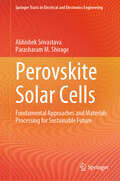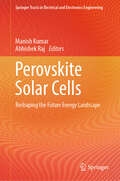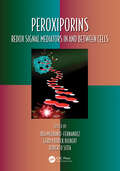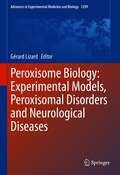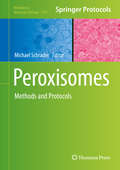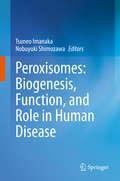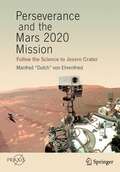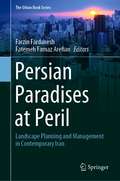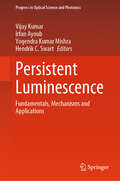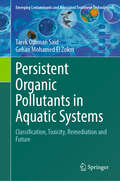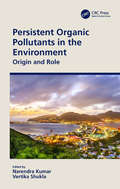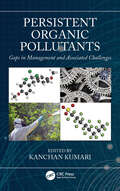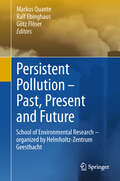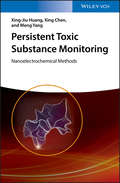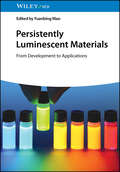- Table View
- List View
Perovskite Solar Cells: Fundamental Approaches and Materials Processing for Sustainable Future (Springer Tracts in Electrical and Electronics Engineering)
by Abhishek Srivastava Parasharam M. ShirageThis book excavates into both the foundational principles and the latest advancements in perovskite solar cell research. It presents ground-breaking results about the diverse applications of perovskite solar cells, offering readers a comprehensive overview of the field's current state. By combining fundamental knowledge with cutting-edge methods, this book equips researchers, students, and professionals with valuable insights, fostering innovation and progress in the realm of perovskite solar cell technology. This volume captivates readers with a diverse array of intriguing topics. The book provides valuable insights into tackling challenges and discovering solutions, from the in-depth exploration of various electrical modeling techniques to the revelation of advanced perovskite fabrication methods. Additionally, readers will be engrossed by the exploration of efficiency improvements and the unveiling of novel applications in the realm of renewable energy. This comprehensive coverage ensures that the book appeals to researchers, engineers, and enthusiasts, inspiring them to delve deeper into the world of perovskite solar cells and contribute to sustainable energy solutions. The book also features an array of detailed illustrations and tables, facilitating a comprehensive comparison of different perovskite types. Through a didactic approach, complex concepts are presented in a reader-friendly manner, enabling researchers and enthusiasts alike to grasp cutting-edge methods, results, and applications in the field of perovskite solar cells. This book serves as a valuable resource, empowering readers to contribute to the advancement of clean energy solutions with a deeper understanding of next-generation technologies. This book offers readers a transformative opportunity to develop a comprehensive understanding of perovskite solar cells. Through its insightful exploration of fundamental principles, cutting-edge methods, and ground-breaking applications, the book equips readers with the knowledge and expertise needed to actively participate in developing next-generation clean energy solutions. This invaluable resource empowers researchers, engineers, and students to embrace the potential of perovskite solar cells, driving innovation and progress in the pursuit of a sustainable and environmentally friendly future.
Perovskite Solar Cells: Reshaping the Future Energy Landscape (Springer Tracts in Electrical and Electronics Engineering)
by Manish Kumar Abhishek RajPerovskite Solar Cells (PSCs) have shown the significant advancement in the field of photovoltaic technologies, which are transforming the renewable energy landscape through their remarkable efficiency and adaptability. This Book explores the synthesis techniques, characterization, and utilization of perovskite materials, including lead-free alternatives, tandem configurations, and novel strategies for indoor and large area PSCs. Featuring detailed analyses of the fundamental optoelectronic properties, stability issues, and device engineering techniques, this volume offers critical insights into the scientific advancements driving innovations in sustainable and high-performance solar energy solutions. This book serves as vital resource for researchers, materials scientists, and industry professionals interested in the groundbreaking potential of perovskite solar cells in redefining the future of photovoltaics.
Peroxiporins: Redox Signal Mediators In and Between Cells (Oxidative Stress and Disease #50)
by Iria Medraño-Fernandez Gerd Patrick Bienert Roberto SitiaTo produce energy, aerobic organisms transform oxygen molecules into water. This reductive mechanism yields toxic radical intermediates, collectively known as reactive oxygen species (ROS). Paradoxically, these physiological processes entail the production of potentially damaging species. Evolution has turned this apparent disadvantage into an opportunity for transmitting information. As a result, redox signaling within the cell is an efficient exquisitely organized process. A key element for its regulation is the physical separation of sources and targets into different cell compartments. Peroxiporins, H2O2 transporting proteins spanning biological membranes, distribute the signal from emitters to receptors. Thus, these channels are strategically situated in the thin line between life and death, guaranteeing adequate but safe signaling. Key Features: - Provides a brief history of the discovery and characterization of peroxiporins- Reviews key findings on hydrogen peroxide transport across biological membranes- Discusses the cartography of redox signaling in crowded cells- Includes lavish illustrations and comprehensive images to facilitate teaching- Highlights recent findings, outstanding controversies and open questions
Peroxisome Biology: Experimental Models, Peroxisomal Disorders and Neurological Diseases (Advances in Experimental Medicine and Biology #1299)
by Gérard LizardThis book provides an overview of the biology and biochemistry of peroxisomes, and discusses the contribution of these organelles to peroxisomal and neurodegenerative diseases.It begins with a detailed introduction to the biogenesis and metabolic functions of peroxisomes, and highlights their role in oxidative stress and in lipid metabolism such as fatty acid oxidation. The following chapters focus on the molecular and clinical aspects of peroxisomal disorders caused by defects in peroxisomal function. In particular, the biological aspects of peroxisomal biogenesis disorders such as Zellweger syndrome and Heimler syndrome are discussed. This includes their underlying genetic causes as well as the biochemical and metabolic defects associated with the disorders. In addition, several chapters cover recent observations suggesting an association between peroxisomal dysfunction and neurodegenerative diseases such as Alzheimer's, Multiple Sclerosis and other degenerative cerebellar pathologies. The final section of the book discusses important cell and animal models for studying the role of peroxisomes in human diseases and presents current therapeutic strategies for their treatment. This book deals with a highly topical subject that is at the heart of current research, and represents a valuable contribution for all students and researchers who want to understand the complex biology of peroxisomes and their role in human diseases.
Peroxisome Proliferator-Activated Receptors (PPARs): Methods and Protocols
by Jihan A. Youssef Mostafa Z. BadrAll three peroxisome proliferator-activated receptor (PPAR) subtypes share a high degree of structural homology but differ in function, tissue distribution and ligand specificity. PPARs play critical roles as regulators of numerous physiological as well as pathophysiological pathways, and efforts are currently underway to fully characterize their functioning and to develop safer and more effective PPAR modulators to treat a myriad of diseases and conditions. In Peroxisome proliferator-Activated Receptors: Methods and Protocols, renowned experts in the PPAR arena provide detailed protocols for investigating these receptors. Chapters contain methods ranging from the cloning of receptors to their knockdown, to protocols exploring posttranslational modifications of PPARs and coactivators, as well as receptor subcellular localization. Also assembled are methods to evaluate the involvement of these receptors in behavior functions, an emerging facet in PPAR research. Written in the successful Methods in Molecular BiologyTM series format, chapters include introductions to their respective topics, lists of the necessary materials and reagents, step-by-step, readily reproducible protocols, and notes on troubleshooting and avoiding known pitfalls.<P><P> With its well-honed methodologies, Peroxisome proliferator-Activated Receptors: Methods and Protocols, will be a useful resource for all seeking to advance their knowledge of this field.
Peroxisome Proliferator-Activated Receptors: Discovery and Recent Advances
by Jihan A. Youssef Mostafa Z. BadrAll three peroxisome proliferator-activated receptor (PPAR) subtypes share a high degree of structural homology while exhibiting differences in function, tissue distribution, and ligand specificity. In Peroxisome Proliferator-Activated Receptors: Discovery and Recent Advances, the authors trace the history of PPAR discovery and detail the receptor structure and its posttranslational modifications. Furthermore, endogenous ligands as well as various classes of exogenous ligands, subtype-selective, dual and pan agonists as well as antagonists, are discussed. In addition, the tissue distribution and versatile functions of PPAR subtypes in major organs are described.<P><P> As PPARs play critical roles as regulators of numerous physiological as well as pathophysiological pathways, Peroxisome Proliferator-Activated Receptors: Discovery and Recent Advances aims to help researchers to develop safer and more effective PPAR modulators as therapeutic agents to treat a myriad of diseases and conditions.
Peroxisomes
by Michael SchraderThis volume provides easily accessible and comprehensive collection of methods, techniques, and strategies to investigate the molecular and cellular biology of peroxisomes in different organisms. Chapters detail valuable instructions, guidelines and protocols for molecular cell biologists, biochemists and biomedical researchers with an interest in peroxisome biology. Chapters in Peroxisomes: Methods and Protocols illustrate the isolation of peroxisomes, investigation of properties of membrane proteins, protocols to investigate and manipulate peroxisomes in cellular systems, detection of peroxisomes, including immunofluorescence, cytochemistry, cryo-immuno electron microscopy, and live cell imaging approaches. Authoritative and practical, Peroxisomes: Methods and Protocols aims to be useful for those already working on peroxisomes as well as for those who would like to start working on this fascinating organelle.
Peroxisomes and their Key Role in Cellular Signaling and Metabolism
by Luis A. del RíoPeroxisomes are a class of ubiquitous and dynamic single membrane-bounded cell organelles, devoid of DNA, with an essentially oxidative type of metabolism. In recent years it has become increasingly clear that peroxisomes are involved in a range of important cellular functions in almost all eukaryotic cells. In higher eukaryotes, including humans, peroxisomes catalyze ether phospholipids biosynthesis, fatty acid alpha-oxidation, glyoxylate detoxification, etc, and in humans peroxisomes are associated with several important genetic diseases. In plants, peroxisomes carry out the fatty acid beta-oxidation, photorespiration, metabolism of ROS, RNS and RSS, photomorphogenesis, biosynthesis of phytohormones, senescence, and defence against pathogens and herbivores. In recent years it has been postulated a possible contribution of peroxisomes to cellular signaling. In this volume an updated view of the capacity and function of peroxisomes from human, animal, fungal and plant origin as cell generators of different signal molecules involved in distinct processes of high physiological importance is presented.
Peroxisomes: Biogenesis, Function, and Role in Human Disease
by Tsuneo Imanaka Nobuyuki ShimozawaThis book provides readers with a comprehensive overview of peroxisomes and their role in human diseases. It starts by describing the history of peroxisome research and then examines in detail the current understanding of the biogenesis and function of peroxisomes. It then focuses on peroxisomal disorders and the involvement of peroxisomes in cancer and age-related diseases, discussing in detail the use of model organisms to elucidate the pathogenesis of peroxisomal disorders and the physiological importance of peroxisomal proteins. Further, the book examines diagnostic and therapeutic strategies in peroxisomal disorders as well as significant recent advances. Lastly, it addresses various topics in peroxisome research, including the isolation of peroxisomes from mammalian tissues and cells, the structural biology of peroxisomal proteins, the lipidomics of peroxisomal disorders, the value of exome sequencing, and neuropsychological testing in X-linked adrenoleukodystrophy. Given its scope, the book is a valuable resource for postgraduate students and researchers in the life sciences and clinicians in the fields of internal medicine, pediatrics, and neurology.
Peroxisomes: Methods and Protocols (Methods in Molecular Biology #2643)
by Michael SchraderThis fully updated volume assembles a comprehensive collection of methods, techniques, and strategies to investigate the molecular and cellular biology of peroxisomes in different organisms. Peroxisome research is on the rise, as novel functions and proteins of this dynamic organelle are still being discovered through studies in model systems including humans, mice, flies, plants, fungi, and yeast, and this progress is reflected in the chapters included in this collection. Written for the highly successful Methods in Molecular Biology series, chapters include introductions to their respective topics, lists of the necessary materials and reagents, step-by-step and readily reproducible laboratory protocols, and tips on troubleshooting and avoiding known pitfalls. Authoritative and up-to-date, Peroxisomes: Methods and Protocols, Second Edition serves as an ideal guide for researchers working on peroxisome- and organelle-based research questions.
Perplexing Paradoxes: Unraveling Enigmas in the World Around Us
by George G. SzpiroWhy does it always seem like the elevator is going down when you need to go up? Is it really true that 0.99999 . . . with an infinite number of 9s after the decimal point, is equal to 1? What do tea leaves and river erosion have in common, per Albert Einstein? Does seeing a bed of red flowers help prove that all ravens are black? Can we make sense of a phrase like “this statement is unprovable”?Exploring these questions and many more, George G. Szpiro guides readers through the puzzling world of paradoxes, from Socratic dialogues to the Monty Hall problem. Perplexing Paradoxes presents sixty counterintuitive conundrums drawn from diverse areas of thought—not only mathematics, statistics, logic, and philosophy but also social science, physics, politics, and religion. Szpiro offers a brisk history of each paradox, unpacks its inner workings, and considers where one might encounter it in daily life. Ultimately, he argues, paradoxes are not simple brain teasers or abstruse word games—they challenge us to hone our reasoning and become more alert to the flaws in received wisdom and common habits of thought.Lighthearted, witty, and conversational, Perplexing Paradoxes presents sophisticated material in an accessible way for all readers interested in the world’s boundless possibilities—and impossibilities.
Perseverance and the Mars 2020 Mission: Follow the Science to Jezero Crater (Springer Praxis Books)
by Manfred "Dutch" von EhrenfriedThis is the comprehensive story of NASA’s pioneering Mars 2020 mission, which at this moment continues to break ground on the surface of the Red Planet.The book takes readers through every stage of the Mars mission, describing its major goals and objectives, the cutting-edge technology and instrumentation onboard the Perseverance rover and other spacecraft components, and the members of the scientific team who steered the mission along the way. Mars 2020 is the first to actually take samples of the Red Planet and prepare them for subsequent return to Earth. The chapters therefore delve into how and why Jezero Crater was selected as the optimal landing and sample collecting site to meet the mission objectives. Featuring dozens of high-resolution images of the mission, this book gives readers a deeper understanding of the technology underlying Mars 2020 and why its work is so important for planetary science and space exploration.
Persevere, Survive, & Thrive: Hard-won Wisdom from Women in Science
by SOWIF Stories of Women in FluidsFor aspiring scientists and science leaders alike, a powerful collection of stories from a diverse group of authors that details the ups and downs experienced by women in STEM—and offers insight into how to make the field more inclusive for all.Imagine walking into a lab or a lecture hall and realizing you&’re the only woman there. For most women in the sciences, this is not a difficult thing to envision; rather, it&’s a familiar reality. Here, fifteen writers representing a wide range of women in STEM, from early-career researchers to accomplished leaders, offer authentic, personal reflections on the obstacles they&’ve faced in this traditionally male-dominated field. These powerful narratives address critical themes—imposter syndrome, balancing personal responsibilities with professional ambitions, and navigating systemic biases such as sexism and racism—and span continents and cultures, illustrating the diversity of experiences while highlighting shared threads of resilience, courage, and the power of mentorship. Through these stories, readers—not just women in STEM but all those committed to building more inclusive and equitable workplaces—will gain a deeper understanding of the lived experiences of women in science and the role we can all play in creating environments where everyone can thrive. Deeply personal yet universally relatable, Persevere, Survive & Thrive is a celebration of courage and persistence—and the power of sharing stories to inspire change.
Persian Paradises at Peril: Landscape Planning and Management in Contemporary Iran (The Urban Book Series)
by Fatemeh Farnaz Arefian Farzin FardaneshThis book offers a resourceful collection of essays examining recent efforts to respond to the challenges of planning, management and conserving landscapes in contemporary Iran, the home of Persian gardens. Drawing on selected recent studies, the chapters discuss the following topics: The sphere of knowledge and theoretical bases, including a survey of recent and ongoing research;Persian gardens remaining from the 6th century BC to the 19th century AD, which have influenced garden design in a vast geographic domain extending from India to Spain;Management and conservation of cultural landscapes, historic urban landscapes (HUL), road landscapes, and natural landscapes in the face of changes in climatic conditions and livelihood practices affecting their delicate dynamic balance and functions essential to their distinctive character; and Historic Territorial Landscapes (HTL) formed and evolved along the Silk and Spice Roads as compositions of tangible and intangible elements resulting from movement, exchanges and dialogue in space and over time.The book is a useful resource for a range of academics and professionals, such as landscape architects and managers, landscape historians and conservationists, and urban planners and managers.
Persistent Luminescence: Fundamentals, Mechanisms and Applications (Progress in Optical Science and Photonics #30)
by Vijay Kumar Hendrik C. Swart Yogendra Kumar Mishra Irfan AyoubThis book presents the fundamental and applied properties of different phosphor materials that exhibit the phenomenon of persistent luminescence (PerLum). PerLum offers a solution for the limitations of existing fluorescent probes, with new lanthanide-based materials for in vivo bio-imaging and demonstrates the practical applications of these materials. The book offers a basic understanding of PerLum, different mechanisms, models, related spectroscopic techniques, and a few applications essential for anyone interested in learning about PerLum materials. This is partly due to the fact that the property of long-lasting luminescence is closely associated with other properties and functionalities, which besides being essential for many technological applications, such as bioimaging and biosensing, involve in-depth physics and chemistry. Although the concept of luminescence has been explored for many decades, the different types of luminescence have always led to versatile breakthroughs in different fields of science and technology. Among the same is one more well-established phenomenon known as "PerLum," which is characterized by the maintenance of luminescence for periods ranging from minutes to hours in the absence of an external excitation source. Because of their remarkable properties, an enormous number of PerLum materials have been developed and are now widely used in a variety of fields, particularly bioimaging, biosensing, therapeutics, etc.
Persistent Organic Pollutants in Aquatic Systems: Classification, Toxicity, Remediation and Future (Emerging Contaminants and Associated Treatment Technologies)
by Gehan Mohamed El Zokm Tarek Othman SaidThis book addressed an in-depth comprehension of the classifications and characterizations of POPs, which have become global issues due to bioaccumulation, persistency, and toxicity. It represents the milestones of the development of pesticide application, industry, and management. Banned SC-POPs have special investigations. It discusses air-sea exchange, ocean currents, phase distribution, speciation, adsorption, desorption, and degradation as the key processes that control POP's fate. The book explores several aspects of POP chemistry that have a direct influence on their biochemical and toxicological consequences. The book illustrates the dynamic equilibriums influencing the proportion of a POP's gaseous, liquid, and solid phases. The book discussed POP migration by referring to the grasshopper effect. It also explores the impacts of climate change on emissions and the fate of POPs through a global-scale multimedia fate model. Additionally, it displays the impact of potential global change scenarios on POP bioaccumulation patterns. The book is directed at giving a deep discussion of the method's QA/QC process for POP determination and has verified the accuracy and precision of the procedures. As a distinctive point, it discusses many aspects concerning the toxicity of POPs. It reports mechanisms describing the toxicity of POPs on immune systems, carcinogenesis, endocrine, neural, and reproductive systems. The book keeps an eye on a model describing the global distribution and toxicity of PAHs. Among the exclusive points in the book is the evaluation of the recent ecological status in Egypt relative to POPs through a time-scale overview and recent case studies. It provides thematic literature related to DDC research in Africa through the WoS and Scopus databases from 1949 to 2021. The book emphasizes models for predicting the annual contribution rate of POPs as a way to raise public awareness about POPs. The greatest challenge for the book is how to motivate the audience to be aware of these hazardous materials in marine ecosystems. Moreover, this book will be of great interest to academics, professionals, practitioners, post-graduate students, and undergraduates because it gives a clear overview of POPs in the marine environment. It also provides decision-makers with a realistic perspective of the environmental file, allowing them to address environmental issues and directing stockholders to safer locations for environmental activity. From a future perspective, the regulation of pervasive POPs, with special reference to recently evaluated harmful substances (PFASs), has faced significant challenges in the wake of pressure from regulators.
Persistent Organic Pollutants in Human Milk
by Peter Fürst Rainer Malisch Kateřina ŠebkováThis open access book reviews the trends of persistent organic pollutants (POPs) in human milk and discusses the main findings of five global surveys that were coordinated by the World Health Organization (WHO) and the United Nations Environment Programme (UNEP) from 2000 to 2019. Human milk was selected as core matrix for human exposure under the Global Monitoring Plan for effectiveness evaluation of the Stockholm Convention on Persistent Organic Pollutants. Milk from well-defined groups of mothers was collected and mixed to form a representative sample per country. Datasets collected represent the largest global human tissues survey with a harmonized protocol, carried out in a uniform format for more than two decades. Altogether 69 countries participated in these studies between 2000 and 2015, and more than 40 countries participated in the study from 2016 to 2019.Divided into 5 parts, the book offers an authoritative overview of human milk biomonitoring; collates the harmonized sampling requirements and analytical methods for the identification and quantification of contaminants in human milk; examines the results of the WHO/UNEP-coordinated exposure studies, including the identification of selected chlorinated pesticides, dioxin-like compounds, industrial chemicals like polychlorinated biphenyls (PCB) and chlorinated paraffins, polybrominated POPs and PFAS, among others; and traces geographic, temporal and cross-substance trends and correlations, and human health risks. The book finishes by providing the reader with the summary of the main findings and outlook from these studies, in which the comparison of concentrations found for the wide range of POPs listed in the Stockholm Convention allowed the identification of possible needs for actions and follow-ups in different countries/regions. This book contributes to the understanding of exposure to hazardous chemicals and pollution as addressed by the UN Sustainable Development Goals on Good Health and Well-being (SDG 3) and will appeal to environmental and analytical chemists, researchers, professionals, and policymakers interested in learning more about contaminants in human milk. Given its breadth, this book will also appeal to a broader audience interested in maternal and child health.
Persistent Organic Pollutants in the Ecosystems of the North Pacific (Earth and Environmental Sciences Library)
by Vasiliy TsygankovThe book reports the results on the fate of POPs in the abiotic and biotic components of the aquatic environment North Pacific Ocean (include Russian part of North Pacific), possible health risks for coastal residents Pacific Ocean exposed to these hazardous pollutants are systematized. In particular, indicator organisms (fish, birds, and mammals), indicating the pollution of the region, were identified; the possible ways of xenobiotic transfer from the sea to the land are shown; the targets of POPs impact on living organisms were determined; the time of circulation of pollutants in the biosphere was determined; a list of “priority” toxicants for the region based on quality screening was compiled; the risks to human health from the consumption of contaminated aquatic organisms were assessed; the levels of POPs in the human body were measured. The book is interesting for specialists in the agro-industrial complex, aquaculture and medicine, teachers and graduate students of universities, researchers, which interested in the problems of persistent organic pollutants (POPs). There are no similar books on the study of POPs in the Russian part of the Pacific Ocean in the world literature. This book is useful to scientists of the world who study the fate of POPs.
Persistent Organic Pollutants in the Environment: Origin and Role
by Narendra KumarPersistent Organic Pollutants (POPs) are toxic, degradation resistant, bio accumulative, and display wide spatial distribution which has been linked to mutagenic, reproductive and immunological disorders. In Stockholm Persistent Organic Pollutants (POPs) are toxic, degradation resistant, bio-accumulative, and display wide spatial distribution, which has been linked to mutagenic, reproductive, and immunological disorders. At the Stockholm Convention, a global treaty was signed to minimize and ultimately eliminate the release of POPs into the environment. The present compilation regarding POPs focusses on the sources, atmospheric behavior, terrestrial and aquatic food chain transfer, human exposure, and fate aspects of this important class of chemicals, including topical issues like temporal trends in contamination. Furthermore, the chemical characteristics of individual POPs are also addressed. Features: Provides better understanding of Persistent Organic Pollutants (POPs) and how they affect humans and ecosystems. Includes genesis, categories, environmental fate and behavior, and associated hazards. Reviews analytical techniques involved in detection, human exposure and management. Discusses environmental dynamics of POPs. Focuses on the comprehensive account of PCDD/Fs, PCBs, PAH and other organochlorine POPs, such as DDT, lindane, and dieldrin. This book is aimed at researchers, professionals and graduate students in Life Science, Occupational Health and Safety, Chemical Engineering and Environmental Engineering.
Persistent Organic Pollutants: Gaps in Management and Associated Challenges
by Kanchan KumariPersistent Organic Pollutants (POPs) are chemicals that resist environmental degradation and cause deleterious effects on the environment and human wellbeing. Once released into the environment they can travel long distances and persist for longer duration. This book highlights the complex area of POPs in simple language and deals with the fundamentals of the chemicals, their sources, and impacts on human health. The book also unfolds several other aspects like new and advanced analytical detection methods, gaps in management, effectiveness of the Stockholm convention, and the role of the global monitoring plan on POPs for crucial and holistic understanding about POPs. It also investigates how to minimize the impact of POPs and the major gaps and challenges in sound management of POPs. With its comprehensive approach, this book is an indispensable source of knowledge for those studying and working to mitigate the effect of POPs in the environment.
Persistent Pollutants in Water and Advanced Treatment Technology (Energy, Environment, and Sustainability)
by Alok Sinha Swatantra P. Singh A. B. GuptaThis contributed volume discusses the current status of the occurrences, fate and transport of persistent pollutants in water and wastewater. This contents compile the state-of-the-art of emerging technologies such as nanotechnology, advanced oxidation process, membrane processes, sorption, etc. for the clean-up of persistent pollutants in water including heavy metals, pharmaceuticals, phenolic compounds as well as microplastics and their by-products. This volume will be useful as a guide for the researchers to build strategies to deal with persistent pollutant. It also discusses the principal aspects of degradation mechanism of the pollutants, toxic by-products and effectiveness of the emerging technologies. This volume will be a useful guide for those working in soil and water protection, and environmental civil engineering.
Persistent Pollution – Past, Present and Future
by Götz Flöser Markus Quante Ralf EbinghausThis book evolved from the 5th School of Environmental Research entitled "Persistent Pollution - Past, Present and Future", which has set a focus on Persistent Organic Pollutants (POPs), heavy metals and aerosols. - reconstruction of past changes based on the scientific analysis of natural archives such as ice cores and peat deposits,- evaluation of the present environmental state by the integration of measurements and modelling and the establishment of cause-effect-patterns,- assessment of possible environmental future scenarios including emission and climate change perspectives.
Persistent Toxic Substance Monitoring: Nanoelectrochemical Methods
by Xing-Jiu Huang Xing Chen Meng YangFilling the urgent need for a professional book that specifies the applications of nanoelectrochemistry for the monitoring of persistent toxic substances, this monograph clearly describes the design concept, construction strategies and practical applications of PTS sensing interfaces based on nanoelectrochemical methods. The comprehensive and systematic information not only provides readers with the fundamentals, but also inspires them to develop PTS monitoring sensors based on functional nanostructures and nanomaterials. Of interestto chemists, electrochemistry researchers, materials researchers, environmental scientists, and companies dealing with electrochemical treatment and environment.
Persistent, Bioaccumulative, and Toxic (PBT) Chemicals: Technical Aspects, Policies, and Practices
by John D. Graham Adam D. Abelkop Todd V. RoyerDeveloped from the efforts of a multiyear, international project examining how persistent, bioaccumulative, and toxic (PBT) chemicals are evaluated and managed, Persistent, Bioaccumulative, and Toxic (PBT) Chemicals: Technical Aspects, Policies, and Practices focuses on improving the processes that govern PBTs. Incorporating science and policy literature—as well as interviews and panel discussions featuring experts from around the world—this book provides you with an international perspective of PBT policies (centering on Europe, Asia, and North America), and reveals major findings and recommendations for improving PBT science, laws, and policies. It includes case studies of specific chemicals, provides an introduction to the overall subject of toxic chemicals, and weighs in on science and policy expansion for PBTs. It also provides summary tables of important PBTs, and discussions on the number of PBTs in commerce, weight of evidence approaches, market deselection, and international management.The text: Assesses the history, current practice, and future of PBT management Considers the roles scientific data, modeling, and conventions play in identifying and regulating PBTs Explores the number of PBTs in commerce and the growing role of weight of evidence (WOE) in the making of PBT determinations Identifies issues that are likely to come up in WOE judgments Examines international, national, subnational, and regional PBT policies Includes a comprehensive and easy-to-understand analysis of PBT science and policy This book reviews the current science, policies, and practices surrounding the regulation of PBTs. It also provides relevant research, recommendations, and suggestions for improving the management and oversight of PBTs.
Persistently Luminescent Materials: From Development to Applications
by Yuanbing MaoA broad view of the booming field in optical materials based on their applications and potentials. Persistent luminescence refers to a property of materials in which they retain luminescence for hours or even days without a source of excitation once being charged. Persistently luminescent materials have found a huge range of technological applications, from optical displays to chemical sensing to information storage and security technologies. This growing field of research and development has never been such an important area of materials science. Persistently Luminescent Materials offers a comprehensive overview of these emerging optical materials and their applications. It presents all major research trends, new information, and novel properties of the major and developing persistently luminescent materials. With detailed information on how to design new materials and create new functionalities, it’s a must for researchers and technologists in virtually every major area of industry. Persistently Luminescent Materials readers will also find: Practical applications in phototherapy, biological imaging, displays, and more Detailed discussion of topics including sustainability techniques, temperature sensing, sterilization, and optical information storage Analysis of how to use persistently luminescent materials to create new theranostic functionalities Persistently Luminescent Materials is ideal for specialists and professionals in the field, but also for a broader readership seeking a perspective of practical needs related to the applications of optical and perticularly persistently luminescent materials.
